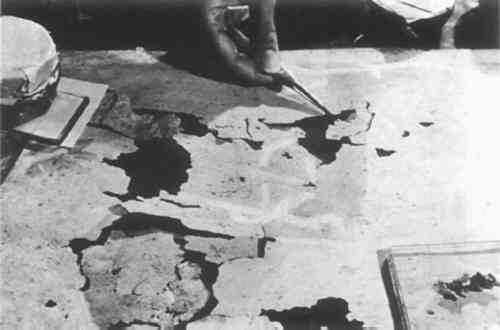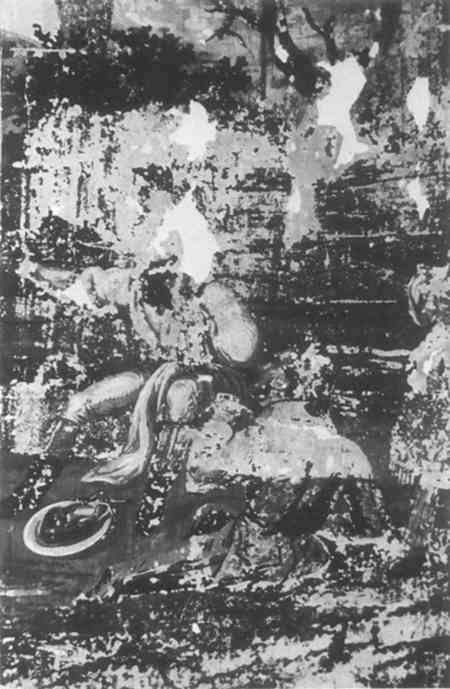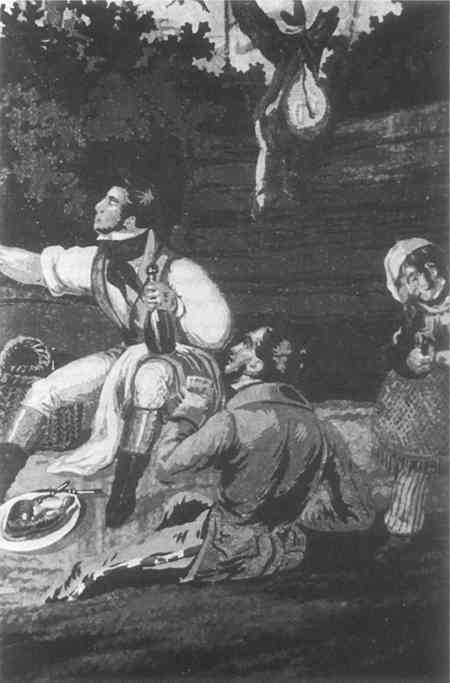THE REMOVAL AND CONSERVATION TREATMENT OF A SCENIC WALLPAPER, PAYSAGE � CHASSES, FROM THE MARTIN VAN BUREN NATIONAL HISTORIC SITE
Patricia Hamm, & James Hamm
4 DISCUSSION OF TREATMENT
4.1 Documentation
THE WALLPAPER WAS photographed with 35mm black-and-white negative film and Ektachrome color transparencies. Each wallpaper panel was divided into three frames. The dado was also divided into separate frames. Each photograph included a number code and color or gray scales. The black-and-white negatives were processed archivally and stored in acid-free folders after being printed on resin-coated paper. The color slides were labeled and presented in clear plastic sleeves in a folder. All photographs were keyed to a diagram detailing their placement. Individual examination report sheets were written on each panel and dado, pointing out tears, losses, stains, etc. A survey report was written on the entire collection of wallpaper, listing dimensions, types of paper, media, binders, etc.
4.2 Prototype
BEFORE BEGINNING the treatment on the entire 45 panels, a prototype was selected—the 5� panels in the southeast corner. The treatment of these panels was carried through to the point of reattachment. When it was complete, it was reviewed. It was at that time that the remaining treatment of 600 square feet was begun.
4.3 Treatment Steps
- The paint layers were consolidated by spraying with a 10% solution of polyvinyl acetate emulsion Jade #403, and a wetting agent. Excess consolidant was removed during the removal of the surface coating.
- The wallpaper was removed from the wall using slight moisture and spatulas.
- More of the consolidant was used to locally strengthen the media's adhesion to the support, and the cupping was partially flattened using local heat and pressure.
- The liner was removed from the verso using slight moisture.
- The adhesive residue, mold, and dirt were removed mechanically from the verso.
- Patching was done using Japanese tissue and wheat starch paste plus PVA emulsion (Fig. 5).
- The oil-resin surface coating was removed using methanol and N.N dimethylformamide as a solution.
- Inserts were shaped and placed in the large losses, and small losses were filled with paper pulp. Two weights of insert papers were employed because of the varying thickness of the paper support.
- Deacidification was done by brushing with magnesium methoxide in methyl alcohol and Freon.
- A consolidating lining was placed on the weakest panels—namely the prototype. A dilute methacrylate emulsion, Rhoplex AC33, on a lightweight western hemp paper was used.
- On all the panels a lining of very fine weave fiberglass with a mixture of emulsions, Rhoplex AC33 and N580,5 was applied under the heat and vacuum pressure of a vacuum hot table.
- A B-72 methacrylate resin in a 10% solution was used as an isolating coating.
- Inpainting was executed in Bocour Magna Colors (Figs. 6, 7).
- A final resin coating was applied using the same B-72 solution.
Fig. 5.
Numerous pieces were carefully fitted back together
 |
Fig. 6.
Before inpainting detail
 |
Fig. 7.
After inpainting detail of same area
 |
4.4 Remounting
REATTACHING to the wall will be done as soon as the restoration of the historic structure is complete—probably in 1982. For that process several interesting factors must be considered:
- Should the wallpaper be placed directly upon the wall, or should it be capable of being removed again, for instance, in the case of damage to the historic house.
- The wallpaper support cannot obscure the decorative moldings at the tops and bottoms of the walls or around the doors and windows.
- The walls are not flat. The moldings are uneven.
- The plaster varies greatly in strength and surface. The newer plaster may require consolidation.
|


